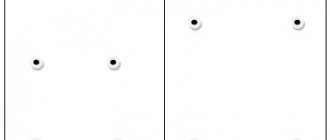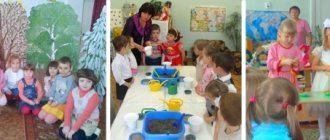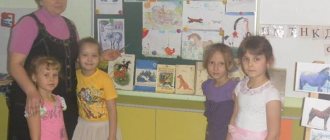Game situation for familiarization with traffic rules in the senior group
"Young traffic experts"
Game situation for older preschoolers
Target:
Consolidating knowledge of traffic rules.
Tasks:
1. Deepen children’s knowledge about the rules of behavior on the road.
Make children aware of the consequences of violating traffic rules. 2. Promote the development of caution and prudence on the roads. 3. Cultivate a respectful attitude towards others. Activation of the dictionary:
traffic light, traffic signals, pedestrian crossing, passenger, road signs, traffic island, roadway, roadside, sidewalk.
Materials and equipment
: Interactive equipment; map with route; casket with disk; puzzles of road signs “Pedestrian crossing”, “Public transport stop”; box with a surprise; poster with a picture of a car; circles of red, yellow and green; easel; icons.
Preliminary work:
1. Reading poems, guessing riddles about road signs; traffic rules games. 2. Looking at traffic signs on the way home from kindergarten. 3. Introducing children to traffic lights, how they work, zebra crossings, and “Pedestrian crossing” and “Bus stop” signs.
Progress of entertainment
While children are playing, the sounds of the street and car engines are heard. The teacher draws the children's attention to them. He asks what those sounds are. They find out that these are the sounds of the streets of our city. There is a knock on the door. The “postman” brings a parcel on which they read: “Kindergarten “Mayachok.” Children of the Firefly group.
They open it, inspect it, there is a disk in it.
Guys, let's see what's on the disk? (Watch a recording of Dunno’s video story.) “Hello, guys! It's me Dunno. I have prepared a gift for you. He is in your group. You can look for it yourself or with my help, but to do this you will need to complete tasks at each station. For each correctly completed task you will receive a hint. You will have to try. The map will help you find tasks. See you. Good luck". Educator
: Well guys, are you interested in what Dunno has prepared? Then let's go on a journey using the map that Dunno sent us. I just wanted to check your readiness. After all, it will be necessary to act harmoniously and amicably. Listen to each other and help each other. Do you agree? “To make sure everything is okay, we’ll play riddles. If you agree with us, shout loudly in response: “This is me, this is me, these are all my friends.”
And clap your hands together - this is necessary for fun! If not, then keep quiet. Which of you goes forward only where there is a pedestrian crossing? (This is me, this is me, these are all my friends) To get some air on the bus, Who stuck both his head and body out the window? (Children are silent) Which of you in the cramped carriage gave up your seat to the old lady? (It's me, it's me, it's all my friends) Who runs forward so fast that they don't see the traffic light? (Children are silent).
Educator
: Well done!
I made sure that you are ready for real tests and are already familiar with the rules of the road! Now let's start searching. We need to find the first task. Let's look at the map and study the route. (Children move along the route and find an envelope with a task). Station 1. “Road signs”
The teacher takes out puzzles from the envelope: a sign for a pedestrian crossing and a bus stop.
Educator
: Here are the pictures.
But it looks like some hooligans cut them up! You need to put them together and see what happens. To do this, we will divide into small teams of boys and girls. (Children complete the first task.) Educator
: Oh, how interesting!
What happened? (Traffic signs). What are these signs called? (Sign for a pedestrian crossing and a bus stop. Well done! The first task is completed, so we take the first hint and move further according to the route.) Station 2. “Components of a car” Educator
: Look at the poster.
Name and show the parts of the car, tell about their purpose. (Wheels - for moving the car, headlights - illuminate the road, trunk - for transporting cargo, interior - for transporting passengers, steering wheel - for steering the car, doors - for closing and opening the interior). Educator: Well done guys, you asked the question, take the second hint. And let's see where the map takes us next. Station 3. “Red, yellow, green” Educator:
At this station, I suggest you move a little.
But first listen to my riddle. Here's a three-eyed fellow. How cunning he is! Whoever comes from anywhere will wink at both this and that. Knows how to settle a dispute, Multicolored...(Traffic light) Now I will be the traffic light. If I raise a red circle, you go back, a yellow circle means you stand still, a green circle means you go forward. Educator
: Smart guys!
You know the traffic lights well, you are not confused, and for this you receive another hint. Station 4. Interactive game “What is possible and what is not?” Educator
: At this station we need to pay attention to the screen.
Look carefully at the pictures with the situations. Tell me which pictures do not follow traffic rules? Why? And how can this be fixed? (A boy plays ball on the roadway, a girl takes an old lady across the road, a full bus is driving with the door open, a mother and daughter are crossing the road not at a pedestrian crossing, a boy is running away from his parents on the road, a girl is riding a bicycle and talking on the phone). Educator: In this task you showed your powers of observation and demonstrated your knowledge of traffic rules, take the fourth clue. Station 5. “Relay Race - Transport” (on the interactive wall)
Educator: Oh, now, I suggest you divide it into a team of girls and boys.
One player from each team (two players play at once) needs to select the desired type of transport and move it to the circle located at the bottom of the playing field in the shortest possible time. After the correct answer, the player needs to pass the baton. Educator:
Well done!
According to the map, this was the last station. This means we completed all the tasks and received all the clues. Let's hang them on the easel and see what we got, where we can look for our gift from Dunno. (Children hang pictures with the image: firefly, bedroom, closet, traffic light, chest.) Educator
: Look carefully at the clues, where is our surprise?
That's right, firefly is the name of our group. That means he’s somewhere here, the next clue is a picture of a locker room – it means in our locker room in a closet with a picture of a traffic light on it. Let's go look. Educator
: Did you find the chest?
Guys, what's there? ("Young traffic experts" badges). Educator
: It turns out that Dunno wanted you to show your knowledge of the rules of the road. You guys are so great! You know them well! Everyone will hang a badge so that everyone can see that you know the rules of the road. And you can teach children of younger groups, tell and explain how to behave on the streets of the city, where they can play. I am sure that you yourself will always follow the rules on the city streets.
Road safety pictures for children
Road safety pictures for children will help you clearly demonstrate to young pedestrians the difference between correct and careless behavior. It will be better if you accompany each image with a small story or ask the children themselves to tell a short story about safe behavior on the road.
You can also familiarize yourself with the selection on the topic of traffic rules “Road rules for children, pictures” and view material about fire safety – pictures for children.
Simple and easy pictures about road safety for children
Cross the road correctly and safely
We walk across the road correctly. When we approach its edge, we always look to the left, and if there are no cars, then we walk boldly. As we reach half of the zebra crossing, we look to the right, if the road is clear, then we move on.
You can't run out onto the road
Denis was playing with a ball near the road, suddenly the ball rolled away, and his feet rushed after the ball. But on the road there is noise from cars and fast driving, you should never do that.
Safe underground passage
There is an underground passage, which is very safe. We always walk along it: dads, children and their mothers.
Safe overpass
There is a road above the ground, it helps a lot. And a cautious pedestrian hurries forward along it.
You cannot cross the road in the wrong place
There is a land crossing, always take it. Remember every pedestrian, then you will avoid trouble!
In order not to lose the article and share it with friends on social networks, save its address by clicking one of the icons:
Or find out about all new materials on Twitter or RSS feed :
Check out similar articles on our website, click on the topic you are interested in:
- terra incognita
- buy clothes for a boy
- glue spray
- shell oil 5w40
Progress of the game.
The teacher names the first part of the sentence, and the child finishes it.
— There was an accident at the intersection because...
— The car was slipping and could not move because...
— A lot of people gathered at the stop because...
— The driver braked at the pedestrian crossing because...
— At the traffic light, all the cars slowed down because...
— The traffic inspector stopped the car because...
— The children couldn’t cross the road because...
— The driver honked at the boy because...
Game "Family of Words "
Senior preschool age
Goal: to consolidate the ability to form words .
Material: ball.
Game actions. Form words with the same root first for the word road , and then for the word car .
Progress of the game.
Teacher: “Guys, now we’ll play with words . I will name the word action words for it as possible ; answer the question “what does it do?” What does the machine do? (Drives, honks, brakes, rushes, stops)
. What is the driver doing? What does a traffic light do? What does the traffic controller do? What is the pedestrian doing?
Children select action words and receive a chip for each correct answer . At the end of the game, children count their chips and name the winner.
Game exercise “Tourists”
Senior preschool age
Target. Development of the lexical and grammatical structure of speech. Mastering the instrumental case of plural nouns.
Progress of the game.
The game is played several times.
For the first time, the adult reads out the text of the route, making a short pause after each verb, and the child shows the route in the picture . Teacher: “Drive your index finger along the road the way a car should drive. Be an attentive driver - drive the car exactly along its route. Let's begin our journey. The car drove and drove and reached the mountain; I drove up the mountain, drove down the mountain, and continued on. I drove around the pit and reached the river; I drove across the bridge, crossed the tracks and came home.”
Next time, the adult is silent, and the child “drives” the car and comments on its movement : “Now tell me what the car’s route was.” Then you can invite the child to travel in the opposite direction .
Game exercise “Vanya’s Journey”
Senior preschool age
Preparatory group for school
Goal: to consolidate the ability to form prefixed verbs of motion .
Game actions. Complete the adult's story with the necessary words .
Progress of the game.
Teacher: Travelers or tourists use different types of transport. Since there are many tourists, there are also many vehicles. Now I will name one vehicle, and you must name what vehicles tourists travel on.
For example: I will say - the tourist will ride a bicycle, and you must say - and the tourists will ride bicycles.
Note: Children must highlight the endings in answer words .
Car, train, plane, steamship, motorcycle, bus, airbus, lunar rover, all-terrain vehicle, jeep, sleigh, rocket, motor ship, train, car, etc.
Game exercise “Happy Journey”
Senior preschool age
Goal: to intensify the use of prefixed verbs.
Material: story picture (see Appendix 1)
.
Game actions. Make up a story based on the plot picture .
Progress of the game.
Teacher: “Guys, Vanya is going to relax at the seaside this summer. Let's help him get there.
From Vanya's house (what he did)
.
(went out, he (did)
.
(crossed)
and further.
(went)
. Vanya to
the road... (approached, sat in the car and... (drove)
. The car drove up the hill... (drove, then she with roller coaster... (went over a bump.
(moved)
. On the way, she met a lake and her car...
(drove around)
. Finally, at
the railway station... (arrived)
. Vanya got on the train and...
(went)
. Soon to another city. (arrived, from the train. (got out, found a stop and went to her.
(approached)
. Got on the bus and went to the beach.
(arrived)
and began to relax."
Game exercise “Say the opposite”
Senior preschool age
Target. Mastering verbs with different prefixes. Development of dexterity, coordination of movements .
Game actions. Selection of antonyms.
Material. Ball.
Progress of the game.
The teacher invites the children to sit on the carpet and places a playing field in front of them - a large circle on which a track is depicted; he gives the children one model of passenger car in different colors. After which the teacher says: “And now you will move your cars around the playing field and tell what are they doing. Try not to repeat yourself . Let your cars perform completely different actions, move along different routes.”
Children perform actions and comment on them: “My red car left the garage and drove down the street. My blue car drove down the street and drove up to the store. My green car drove up to the bridge, drove onto the bridge, drove across the bridge, drove off the bridge. My yellow car drove around the house, across the street and into the garage.”
The teacher says after all the children’s answers: “What similar words were heard in your answers? (Check out, went, drove in, moved out, drove around, drove in, moved)
.
All these words are derived from the word “to go .”
Note. If children find it difficult, the teacher can ask leading questions.
Game exercise “Pick up a small word “
Senior preschool age
Goal: to intensify the use of simple prepositions.
Game actions. Choose the right preposition.



